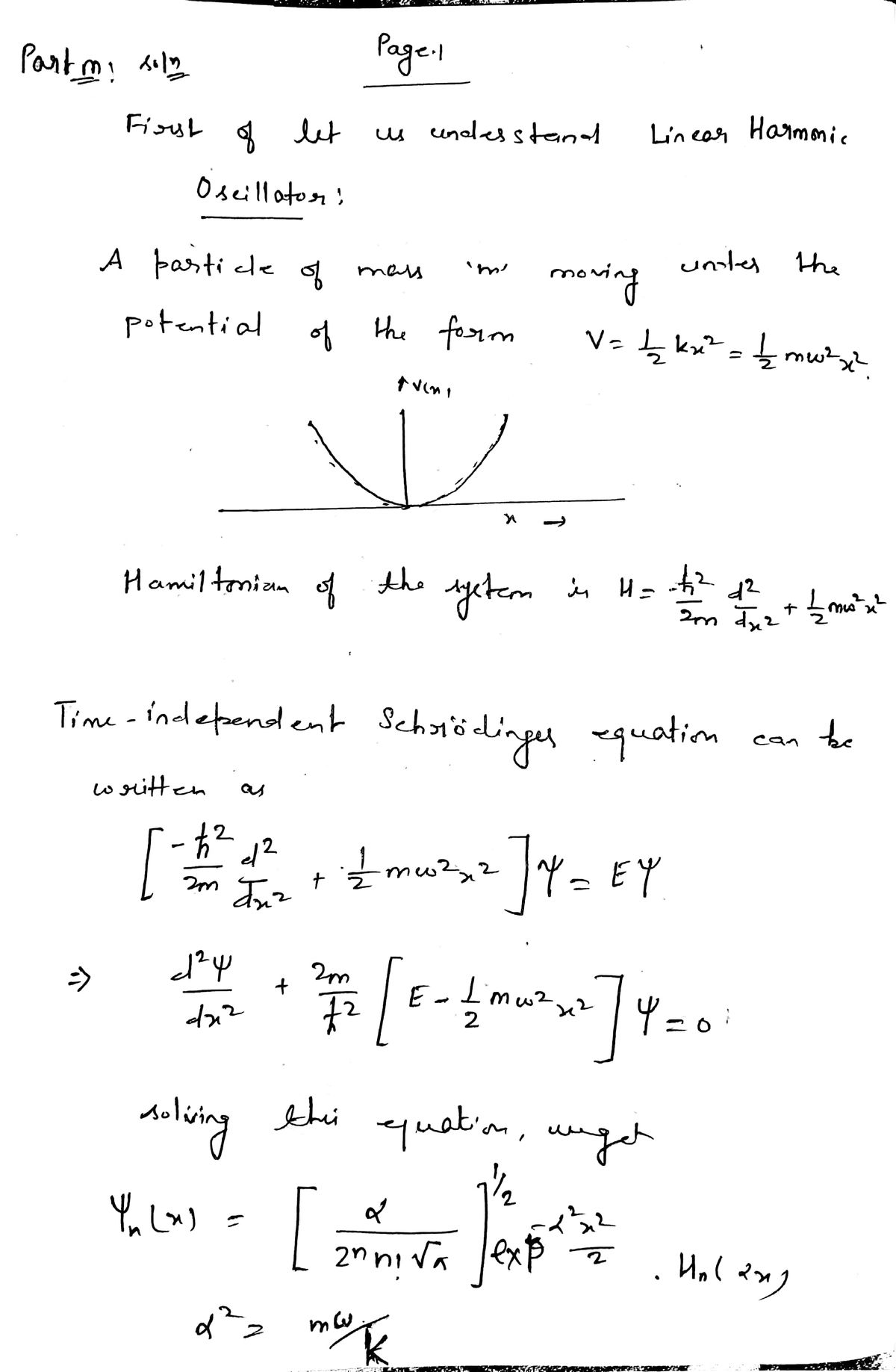m. Find the expression of the momentum operator square, j7, in terms of the Fock oper- ators. n. Compute (Olji(0) and (0lP10).
m. Find the expression of the momentum operator square, j7, in terms of the Fock oper- ators. n. Compute (Olji(0) and (0lP10).
Related questions
Question
Please do M and N
![Transcription of Educational Content:
---
**Problem Set: Quantum Operators and Eigenstates**
g. **Normalization of |n⟩:**
- Find \( A_n \) by normalizing |n⟩. Use the identity \({\langle n | Q | 0 \rangle = \langle 0 | Q^\dagger | n \rangle^*}\) for \(Q = \hat{a}^\dagger\).
h. **Eigenstates of \(\hat{H}\):**
- Show that |n⟩ are the eigenvectors of \(\hat{H}\), i.e.,
\[
\hat{H} | n \rangle = E_n | n \rangle
\]
(Equation 7)
- Determine the energy eigenvalue \(E_n\). Knowing that \(\hat{H}\) is an observable, what can you infer about \( \langle m | n \rangle \) for \(m \neq n\)?
i. **Validation of Formulas:**
- Verify the following formulas:
\[
\hat{a}^\dagger | n \rangle = \sqrt{n+1} | n+1 \rangle
\]
(Equation 8a)
\[
\hat{a} | n \rangle = \sqrt{n} | n-1 \rangle
\]
(Equation 8b)
- Provide a general proof or show that they hold for \(n = 0, 1, 2, 3\).
j. **Unit Analysis:**
- Refer back to Equation (2). Determine the SI unit of the coefficient \(\sqrt{\frac{\hslash}{2m\omega}}\). Does it seem reasonable to you?
k. **Position Operator Square:**
- Demonstrate that the square of the position operator is
\[
\hat{x}^2 = \frac{\hslash}{2m\omega}(\hat{a}^\dagger \hat{a} + \hat{a} \hat{a}^\dagger)
\]
(Equation 9)
l. **Expectation Values:**
- Compute \(\langle 0 |\hat{x}|0 \rangle\) and \](/v2/_next/image?url=https%3A%2F%2Fcontent.bartleby.com%2Fqna-images%2Fquestion%2Ffa4426dc-92c3-4ac7-bd5a-9ba1dd10b9af%2Fee740665-08e3-4c2c-bc4f-1229d9b6f268%2Fo90fwh_processed.png&w=3840&q=75)
Transcribed Image Text:Transcription of Educational Content:
---
**Problem Set: Quantum Operators and Eigenstates**
g. **Normalization of |n⟩:**
- Find \( A_n \) by normalizing |n⟩. Use the identity \({\langle n | Q | 0 \rangle = \langle 0 | Q^\dagger | n \rangle^*}\) for \(Q = \hat{a}^\dagger\).
h. **Eigenstates of \(\hat{H}\):**
- Show that |n⟩ are the eigenvectors of \(\hat{H}\), i.e.,
\[
\hat{H} | n \rangle = E_n | n \rangle
\]
(Equation 7)
- Determine the energy eigenvalue \(E_n\). Knowing that \(\hat{H}\) is an observable, what can you infer about \( \langle m | n \rangle \) for \(m \neq n\)?
i. **Validation of Formulas:**
- Verify the following formulas:
\[
\hat{a}^\dagger | n \rangle = \sqrt{n+1} | n+1 \rangle
\]
(Equation 8a)
\[
\hat{a} | n \rangle = \sqrt{n} | n-1 \rangle
\]
(Equation 8b)
- Provide a general proof or show that they hold for \(n = 0, 1, 2, 3\).
j. **Unit Analysis:**
- Refer back to Equation (2). Determine the SI unit of the coefficient \(\sqrt{\frac{\hslash}{2m\omega}}\). Does it seem reasonable to you?
k. **Position Operator Square:**
- Demonstrate that the square of the position operator is
\[
\hat{x}^2 = \frac{\hslash}{2m\omega}(\hat{a}^\dagger \hat{a} + \hat{a} \hat{a}^\dagger)
\]
(Equation 9)
l. **Expectation Values:**
- Compute \(\langle 0 |\hat{x}|0 \rangle\) and \
![**Exercise #4 (updated)**
The Fock operator \( \hat{a} \) is defined by
\[
\hat{a} = \sqrt{\frac{m \omega}{2 \hbar}} \left( \hat{x} + \frac{i}{m \omega} \hat{p} \right)
\]
where \( \hat{x} \) and \( \hat{p} \) are the position and momentum operators, respectively.
**a.** Write down \( \hat{a}^\dagger \) in terms of \( \hat{x} \) and \( \hat{p} \).
**b.** Show that
\[
\hat{x} = \sqrt{\frac{\hbar}{2m \omega}} (\hat{a} + \hat{a}^\dagger) \tag{2}
\]
\[
\hat{p} = i \sqrt{\frac{m \hbar \omega}{2}} (\hat{a}^\dagger - \hat{a}) \tag{3}
\]
hold.
**c.** Show that the canonical commutation relation, \( [\hat{x}, \hat{p}] = i\hbar \), yields the so-called bosonic commutation relation,
\[
[\hat{a}, \hat{a}^\dagger] = 1. \tag{4}
\]
**d.** Show that the Hamiltonian of the SHO, \( H = \frac{p^2}{2m} + \frac{m \omega^2 x^2}{2} \), is written as
\[
\hat{H} = \hbar \omega \left( \hat{N} + \frac{1}{2} \right) \tag{5}
\]
where \( N = \hat{a}^\dagger \hat{a} \) is called the number operator.
**e.** Show that \( \hat{N} \) is Hermitian. Suggestion: Use the identity from Exercise #1, \( (QR)^\dagger = R^\dagger Q^\dagger \).
**f.** A normalized vector \( |0\rangle \) (so that \( \langle 0|0 \rangle = 1 \)) is defined to satisfy \( \hat{a}|0\rangle](/v2/_next/image?url=https%3A%2F%2Fcontent.bartleby.com%2Fqna-images%2Fquestion%2Ffa4426dc-92c3-4ac7-bd5a-9ba1dd10b9af%2Fee740665-08e3-4c2c-bc4f-1229d9b6f268%2Fa6y1hul_processed.png&w=3840&q=75)
Transcribed Image Text:**Exercise #4 (updated)**
The Fock operator \( \hat{a} \) is defined by
\[
\hat{a} = \sqrt{\frac{m \omega}{2 \hbar}} \left( \hat{x} + \frac{i}{m \omega} \hat{p} \right)
\]
where \( \hat{x} \) and \( \hat{p} \) are the position and momentum operators, respectively.
**a.** Write down \( \hat{a}^\dagger \) in terms of \( \hat{x} \) and \( \hat{p} \).
**b.** Show that
\[
\hat{x} = \sqrt{\frac{\hbar}{2m \omega}} (\hat{a} + \hat{a}^\dagger) \tag{2}
\]
\[
\hat{p} = i \sqrt{\frac{m \hbar \omega}{2}} (\hat{a}^\dagger - \hat{a}) \tag{3}
\]
hold.
**c.** Show that the canonical commutation relation, \( [\hat{x}, \hat{p}] = i\hbar \), yields the so-called bosonic commutation relation,
\[
[\hat{a}, \hat{a}^\dagger] = 1. \tag{4}
\]
**d.** Show that the Hamiltonian of the SHO, \( H = \frac{p^2}{2m} + \frac{m \omega^2 x^2}{2} \), is written as
\[
\hat{H} = \hbar \omega \left( \hat{N} + \frac{1}{2} \right) \tag{5}
\]
where \( N = \hat{a}^\dagger \hat{a} \) is called the number operator.
**e.** Show that \( \hat{N} \) is Hermitian. Suggestion: Use the identity from Exercise #1, \( (QR)^\dagger = R^\dagger Q^\dagger \).
**f.** A normalized vector \( |0\rangle \) (so that \( \langle 0|0 \rangle = 1 \)) is defined to satisfy \( \hat{a}|0\rangle
Expert Solution
Step 1

Step by step
Solved in 5 steps with 5 images
